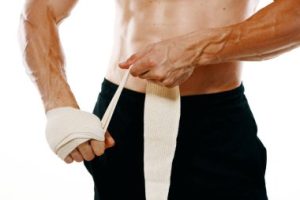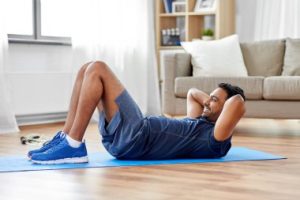
Can You Exercise With Stitches (7 Important Facts)
Can you exercise with stitches? This common question arises frequently among those eager to return to physical activity after a minor surgery or injury. Getting stitches doesn’t have to put a complete halt to your active lifestyle. While it’s essential to prioritize healing, you might be surprised to learn that some exercises can be safe and even beneficial during recovery. The key lies in understanding your body’s limits and adapting your routine to avoid compromising the healing process. By taking a mindful approach to exercise with stitches, you can maintain your fitness, boost your mood, and aid your recovery—all while ensuring your wound heals properly.

Can You Exercise With Stitches
Exercising with stitches can be risky and may lead to complications. It is essential to follow medical advice to avoid reopening wounds, causing infections, or delaying healing. Typically, doctors advise resting the stitched area to ensure proper recovery. Depending on the location and severity of the stitches, some light activity might be allowed after a few days. However, it’s crucial to listen to your body and stop if you experience pain or discomfort.
Understanding the Impact of Exercise on Healing
Stitches, also known as sutures, are used to close wounds and promote healing. Engaging in exercise too soon after receiving stitches can exert pressure on the wound, potentially causing it to reopen or bleed. The physical activity might also lead to swelling and pain, increasing the likelihood of complications.
Additionally, sweat can introduce bacteria to the wound, heightening the risk of infection. Therefore, it’s vital to give your body time to heal and follow your healthcare provider’s recommendations, which might include avoiding activities that involve the stitched area or opting for low-impact exercises that don’t strain the wound.
Recommended Rest and Activity Levels
Rest is a crucial component of the healing process, and many healthcare professionals emphasize its importance when dealing with stitches. Depending on the type and location of the stitches, rest periods can vary. For instance, stitches on the abdomen may require more extended rest compared to those on a less mobile area like the arm.
It’s common for doctors to advise avoiding heavy lifting, running, or activities that could stretch or strain the area for at least a week or until the stitches are removed. Some light walking or gentle stretching might be permissible, but it’s important to seek specific guidance from your doctor to avoid any setbacks in healing.
Safe Exercise Alternatives During Recovery
During recovery, it’s crucial to modify your exercise routine to accommodate your body’s needs. Focus on exercises that don’t involve the stitched area. For example, if your stitches are on your upper body, consider activities like walking or cycling, which primarily engage the lower body. Similarly, if you have stitches on your leg, upper body workouts like seated arm exercises or light resistance training might be suitable. Always prioritize your safety and comfort, and consult with a healthcare professional before resuming any exercise regimen. Keeping the wound clean and dry is equally important to prevent infections and support optimal healing.
Factors to Consider
When considering how stitches impact exercise, it’s crucial to evaluate various factors such as the location of the stitches, the type of stitches used, the nature of the wound, and a doctor’s recommendations. The location of stitches significantly influences the range of motion and type of exercise that can be safely performed. Stitches on the limbs, such as arms or legs, may limit activities that require extensive movement or weight-bearing, as these areas are highly involved in physical activity.
For stitches on the abdomen, exercises that strain the core or involve stretching might need to be avoided to prevent reopening the wound. Stitches on the face or head are sensitive due to the facial muscles’ involvement in many expressions and activities, and they may require extra caution to avoid tension or irritation. Joints, which experience a lot of movement and stress, may also pose a risk for disrupting healing if not given adequate time to rest.
The type of stitches used is another important consideration; dissolvable stitches, which are typically used for internal wounds, might require a different care regimen compared to non-dissolvable stitches that need to be removed by a healthcare professional. Superficial stitches are on the skin’s surface and generally heal faster than deep stitches, which involve deeper layers of tissue and may take longer to recover.
The nature of the wound itself is critical—whether it was caused by surgery, an injury, or another factor can dictate the level of care required. Larger or deeper wounds might necessitate a longer recovery period and more stringent exercise limitations. Lastly, consulting with healthcare professionals is essential to determine a safe exercise plan, as they can provide personalized advice based on the individual’s specific circumstances and overall health condition. Following a doctor’s recommendations can help ensure that the wound heals properly while minimizing the risk of complications during recovery.

Types of Exercises
Engaging in a variety of exercises can significantly benefit physical health and well-being. Low-impact exercises, such as walking, stretching, and yoga, are excellent for individuals recovering from injuries or surgeries, including those with stitches. Walking is a gentle cardiovascular exercise that helps improve circulation and maintain mobility without placing excessive stress on healing tissues. Stretching can enhance flexibility and prevent stiffness in the muscles and joints, promoting overall recovery. Yoga combines stretching with deep breathing and meditation, offering a holistic approach to healing by reducing stress and encouraging mindfulness.
High-impact exercises, like running, jumping, and weightlifting, are typically more strenuous and should be approached with caution by those with stitches, as these activities can increase the risk of reopening wounds or causing complications. However, once cleared by a healthcare professional, these exercises can help build strength, endurance, and cardiovascular fitness.
Water-based exercises, such as swimming, offer a low-impact, full-body workout that is easy on the joints and muscles. However, it is crucial to consider the risk of infection when swimming with stitches, as water exposure can introduce bacteria into the healing area. It is advisable to wait until stitches are removed and wounds are fully healed before resuming swimming to minimize infection risks. Overall, the choice of exercise should be tailored to the individual’s health status, fitness level, and the advice of a healthcare provider to ensure safe and effective physical activity during recovery.

Risks of Exercising with Stitches
Exercising with stitches poses several risks that can compromise the healing process and lead to further complications. One of the primary concerns is wound dehiscence, which refers to the reopening of a wound that was previously stitched closed. This can occur when physical activity places undue stress or tension on the stitches, pulling the wound apart and causing it to reopen. The risk of wound dehiscence is particularly high in areas of the body that are subject to frequent movement or stretching, such as joints.
In addition to the mechanical forces that can disrupt the wound closure, exercising can also increase the risk of infection. Physical activity often leads to sweating, which can introduce bacteria into the wound site. Sweat can also cause the skin around the stitches to become moist, creating an ideal environment for bacterial growth. This can lead to infections that may require additional medical treatment and prolong the healing process.
Furthermore, exercising too soon after receiving stitches can delay healing by placing unnecessary stress on the affected area. Movement can disrupt the formation of new tissue and prevent the wound edges from adhering properly, leading to a longer recovery time.
This delayed healing can also increase the likelihood of scarring, as continuous tension and movement can cause the scar tissue to form improperly. When a wound is subjected to excessive tension during the healing phase, it can lead to hypertrophic or widened scars, which may be more noticeable and aesthetically undesirable. To minimize these risks, it is essential to follow medical advice regarding physical activity after receiving stitches and allow adequate time for the wound to heal before resuming exercise.
Guidelines for Exercising with Stitches
Exercising with stitches requires careful attention to ensure proper healing and to avoid complications. One of the most critical precautions is keeping the wound clean and dry, as moisture and bacteria can lead to infection. It’s important to wash your hands before touching the wound or changing dressings, and to use clean, dry bandages to cover the stitches when necessary, especially during activities that might cause sweating or exposure to dirt. Additionally, it is crucial to watch for signs of infection, such as increased redness, swelling, or discharge, as these symptoms may indicate the need for medical attention.
When it comes to exercise modifications, it’s essential to adjust your routine to minimize strain on the stitched area. This might involve avoiding certain movements or exercises that directly impact the wound or cause undue pressure. Using protective coverings or bandages can provide an extra layer of security, particularly for stitches located in high-movement areas. If you experience pain or discomfort, it is vital to listen to your body and reduce or modify activities accordingly.
Gradually increasing your activity level is recommended, allowing you to monitor how your body responds as healing progresses. Always consult with a healthcare professional before resuming any exercise regimen to ensure that your specific situation is addressed safely. Remember, patience and cautious progression are key to preventing complications and promoting optimal healing.
Specific Scenarios
When dealing with stitches on different parts of the body, it’s important to consider how they might impact mobility and which specific exercises should be avoided to ensure proper healing. For stitches on the limbs, particularly on joints like knees or elbows, mobility can be significantly impacted. It’s crucial to avoid exercises that put pressure or strain on the stitched area, as this can cause the stitches to tear or the wound to reopen. High-impact activities, such as running, jumping, or heavy lifting, should be avoided, as well as any exercise that involves bending or stretching the stitched limb. Gentle range-of-motion exercises may be permitted, but it’s essential to follow medical advice closely.
For stitches on the abdomen, avoiding core exercises is paramount, as these can put undue stress on the abdominal muscles and potentially disrupt the healing process. This includes exercises like sit-ups, crunches, or any form of heavy lifting that engages the core muscles. It’s best to avoid any exercise that might lead to the straining of abdominal muscles until the stitches are removed and healing is confirmed by a healthcare provider.
When stitches are located on the face or head, the focus should be on avoiding exercises that could increase blood pressure or pose a risk of impact to the head. High-intensity workouts that lead to elevated heart rates and increased blood pressure should be avoided to prevent complications such as bleeding or swelling at the wound site.
Additionally, contact sports or activities where there is a risk of falling or head impact should be completely avoided. Light activities such as walking or gentle stretching are typically safe, but it’s always best to consult with a healthcare professional before resuming any exercise routine. In all cases, listening to your body and prioritizing rest and recovery will aid in a quicker and more effective healing process.

Post-Healing Considerations
After stitches are removed or the wound has healed, it’s important to carefully consider post-healing care to ensure optimal recovery and minimal scarring. Resuming normal activity should be done gradually and with caution. Typically, the timeline for returning to full exercise can vary depending on the severity and location of the wound, as well as individual healing rates. For minor wounds, light activities might be resumed within a week or two, while more strenuous exercises should be postponed for at least 4 to 6 weeks, or as advised by a healthcare professional. It’s crucial to listen to your body and avoid pushing through pain, as this can lead to complications or re-injury.
Incorporating rehabilitation exercises is essential for restoring strength and flexibility post-healing. These exercises should focus on the area around the wound, with gentle stretching and strengthening movements to prevent stiffness and improve function. For instance, if the stitches were in the leg, starting with low-impact activities like walking or cycling before progressing to more intense exercises can be beneficial. Additionally, focusing on core and overall body strength can help in maintaining balance and reducing strain on the healing area.
Scar management is another critical aspect of post-healing care. To minimize scarring, techniques such as gentle massage around the scar area can improve circulation and promote healing. Using creams or ointments containing silicone or other scar-reducing ingredients can also be helpful. Applying these products as directed and keeping the area moisturized can improve the appearance of the scar over time.
Sun protection is equally important; scars can darken and become more noticeable if exposed to the sun, so using sunscreen or keeping the area covered can prevent this. Consistency in these practices will yield the best results, but it’s important to manage expectations, as some scarring is natural and part of the body’s healing process. Consulting with a healthcare provider for personalized recommendations is always advised to ensure safe and effective recovery.
Frequently Asked Questions: Can You Exercise With Stitches
Q1. Can I exercise with stitches?
A. It’s generally advisable to avoid exercising immediately after getting stitches, as physical activity can disrupt the healing process. Always consult your healthcare provider for personalized advice based on the location and severity of your wound.
Q2. How soon can I return to exercise after getting stitches?
A. The timeline for resuming exercise varies depending on factors like the type of wound, its location, and your overall health. Typically, you may need to wait anywhere from a few days to several weeks. Your doctor can provide specific guidance based on your situation.
Q3. What types of activities should I avoid while I have stitches?
A. Avoid activities that put strain on the stitched area, such as heavy lifting, running, or contact sports. Any movement that stretches or puts pressure on the wound can increase the risk of reopening the stitches or causing an infection.
Q4. Are there any exercises that are safe to do with stitches?
A. Low-impact exercises that don’t involve the affected area may be safe, such as walking, light stretching, or stationary cycling. However, always get approval from your healthcare provider before starting any exercise routine.
Q5. What are the risks of exercising too soon with stitches?
A. Exercising too soon can lead to complications such as reopening the wound, infection, increased swelling, and delayed healing. These complications can result in prolonged recovery time and may require additional medical intervention.
Q6. How can I protect my stitches during exercise?
A. If you have clearance to exercise, protect your stitches by covering them with a clean, dry bandage, avoiding direct pressure, and stopping immediately if you feel any pain or discomfort. Keep the area dry and clean to prevent infection.
Q7. What should I do if my stitches come undone during exercise?
A. If your stitches come undone, stop exercising immediately and contact your healthcare provider. They will assess the wound and determine whether additional treatment is necessary to prevent infection and promote healing.
Q8. How do I know when my stitches are fully healed and it’s safe to exercise again?
A. Your doctor will usually provide instructions on when to have your stitches removed or when they will dissolve on their own. Follow their guidance on when you can safely return to your normal exercise routine without restrictions.
Q9. Can I swim with stitches?
A. Swimming is generally not recommended while you have stitches because prolonged exposure to water can increase the risk of infection. Wait until your stitches are fully healed and you have your doctor’s approval before swimming.
Q10. What signs should I watch for to ensure my stitches are healing properly?
A. Look for signs of healing, such as reduced redness, swelling, and tenderness around the wound. Be alert for signs of infection, including increased pain, redness, warmth, discharge, or fever, and contact your healthcare provider if you notice any of these symptoms.
Conclusion
Exercising with stitches requires careful consideration and often depends on the location of the stitches, the nature of the injury or surgery, and your overall health. It is generally recommended to avoid strenuous activities that could put strain on the stitched area to prevent complications such as tearing or infection.
However, light activities that do not stress the stitches, such as walking or gentle stretching, may be permissible and can even aid in recovery by promoting circulation and preventing stiffness. Always consult with a healthcare professional to get personalized advice and ensure that your exercise regimen is safe for your specific situation. Following their guidance will help you heal properly while maintaining some level of physical activity.